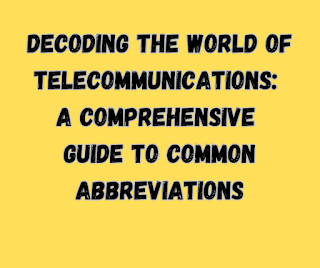Telecommunications is a field with many technical terms and abbreviations. Here are some common telecommunications abbreviations:
- LTE - Long-Term Evolution
- 3G - Third Generation
- 4G - Fourth Generation
- 5G - Fifth Generation
- VoIP - Voice over Internet Protocol
- DSL - Digital Subscriber Line
- ISP - Internet Service Provider
- LAN - Local Area Network
- WAN - Wide Area Network
- PSTN - Public Switched Telephone Network
- IP - Internet Protocol
- TCP/IP - Transmission Control Protocol/Internet Protocol
- MAC - Media Access Control
- DNS - Domain Name System
- URL - Uniform Resource Locator
- SSID - Service Set Identifier
- VPN - Virtual Private Network
- ISP - Internet Service Provider
- Fiber - Optical Fiber
- NAT - Network Address Translation
- POP - Point of Presence
- SMTP - Simple Mail Transfer Protocol
- IMAP - Internet Message Access Protocol
- POP3 - Post Office Protocol version 3
- SMS - Short Message Service
- MMS - Multimedia Messaging Service
- HTML - Hypertext Markup Language
- TCP - Transmission Control Protocol
- UDP - User Datagram Protocol
- SSH - Secure Shell
- FTP - File Transfer Protocol
- VoLTE - Voice over LTE
- QoS - Quality of Service
- CDMA - Code Division Multiple Access
- GSM - Global System for Mobile Communications
- SIM - Subscriber Identity Module
- BTS - Base Transceiver Station
- IMSI - International Mobile Subscriber Identity
- SMS - Short Message Service
- MMS - Multimedia Messaging Service
- PIN - Personal Identification Number
- PUK - Personal Unblocking Key
- APN - Access Point Name
- HTML - Hypertext Markup Language
- HTTPS - Hypertext Transfer Protocol Secure
- VLAN - Virtual Local Area Network
These are just a selection of abbreviations commonly used in telecommunications. The field is continually evolving, so new abbreviations and terms may emerge over time.














